The candelabra aloe in art, gardening and medicine.
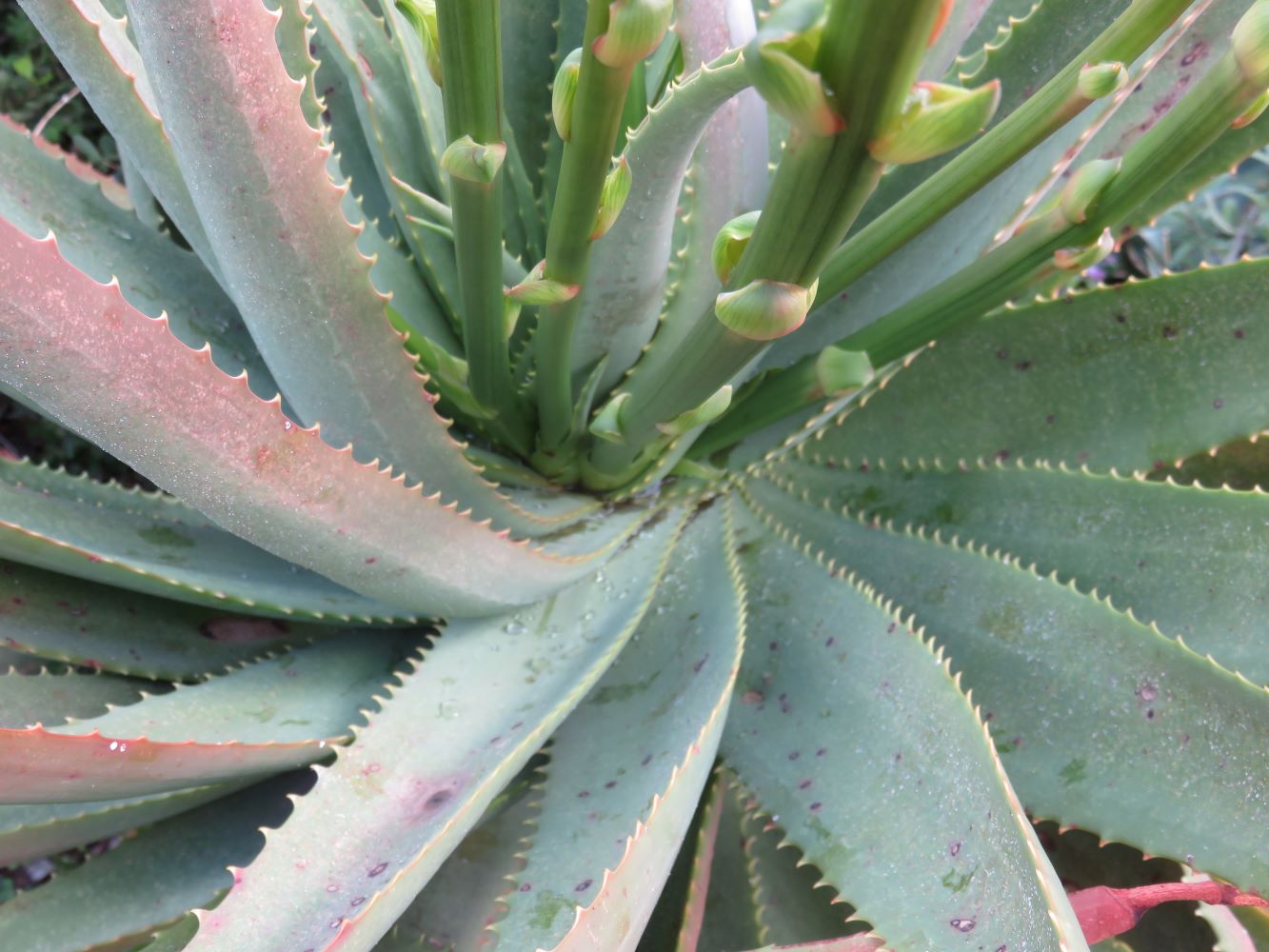 The candelabra aloe may appear messy at a distance, but its heart is all geometric precision
The candelabra aloe may appear messy at a distance, but its heart is all geometric precisionThe naming if plants is fascinating
The candelabra aloe has many other names, as is typical for plants with a wide distribution over many countries with different languages. In South African languages it is also called ikalene (isiXhosa) and inkalane or umhlabana in isiZulu, and kransaalwyan in Afrikaans. Kransaalwyn means 'cliff aloe', ikalene means 'fit', inkalane 'it is enough' and Umhlaba is 'the home', or so I deduce from online dictionaries. In English it is called candelabra aloe, mountain bush aloe, tree aloe or krantz aloe.
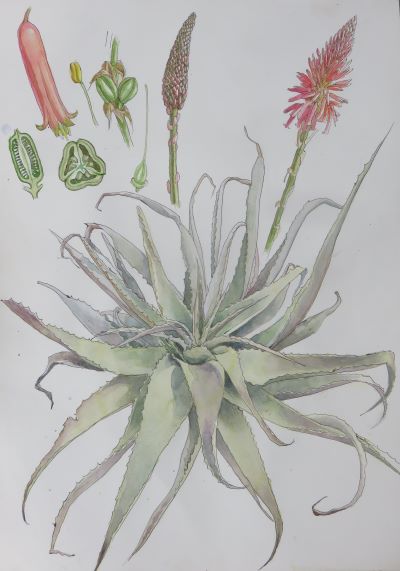 Aloe watercolor painting, available as prints below
Aloe watercolor painting, available as prints below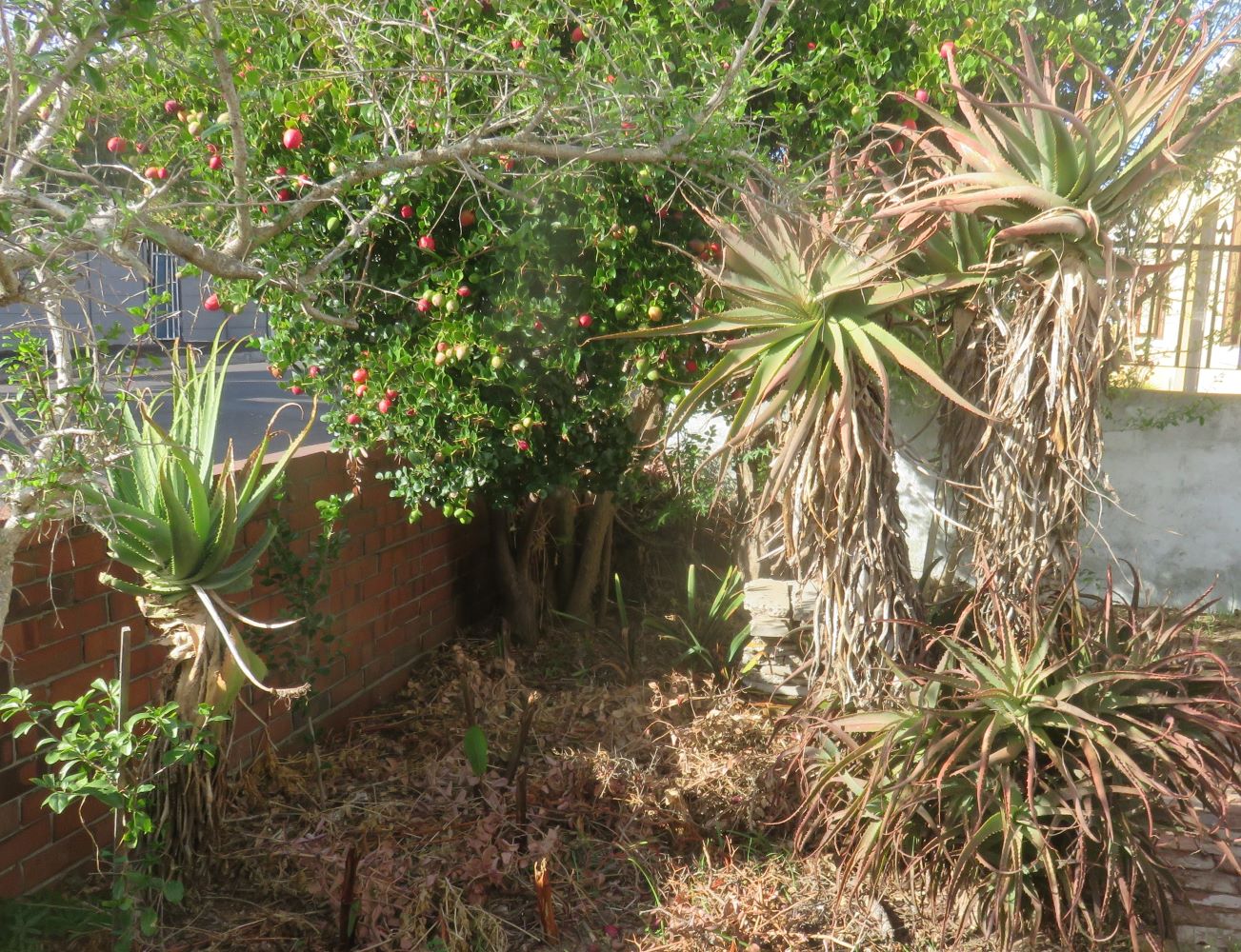 Tall heads of Aloe arborescens. The one growing at the street wall has been harvested by passers by for medicinal and cosmetic use.
Tall heads of Aloe arborescens. The one growing at the street wall has been harvested by passers by for medicinal and cosmetic use.The name Aloe is from the Greek alsos for 'bitter', referring to the bitter juice found in many aloes. The Greek word may come from the Arabic alloeh or Hebrew allal meaning bitter. Arborescens means tree like. The aloe that is referred to six times in the bible is not Aloe vera as the its sales people claim, but aloe wood. Aquilaria agallochum or allow wood is a completely different and highly aromatic plant, which is clear from the quotations.
The Latin name of this A. arborescens was formerly Aloe mutabilis, which is now applied to a smaller cliff dwelling variant in the Witwatersrand National Botanical Garden.
Surmised symbolism of the aloe in European art
If you search for art featuring aloes you will be overwhelmed. There is so much botanical art, as well as landscape painting of the impressionistic kind that depicts various kinds of aloes, that one doesn't know where to begin a coherent story. I notice that what British painters call aloes are frequently not aloes at all, but South American Yucca and Agave, and the meaning of the word varies in common usage from place top place.
I think some reasons for the prevalence of the aloe in landscape painting, especially that of South African artists, is its symbolism as a quintessentially African plant, as well as its strong outline, sculptural qualities and bright flower color. As you head out of the Cape and pass through the chain of surrounding mountains, the aloes appear, standing like soldiers on the mountain slopes, braving the shimmering heat. They seem to be a sign of a different climate, sentinels in a drier, hotter, less peopled South Africa of the semi desert. They could have become a symbol in European painting for the wild, empty, mysterious Africa of European fantasy. For these artists, aloes make the landscape strange perhaps. I am a transplant in Africa and we lack the deep history of relationship with local plants, therefore I must tread cautiously here, but I imagine that perhaps for indigenous people, aloes have the opposite symbolism, not of the unknown and mysterious but of the deeply familiar.
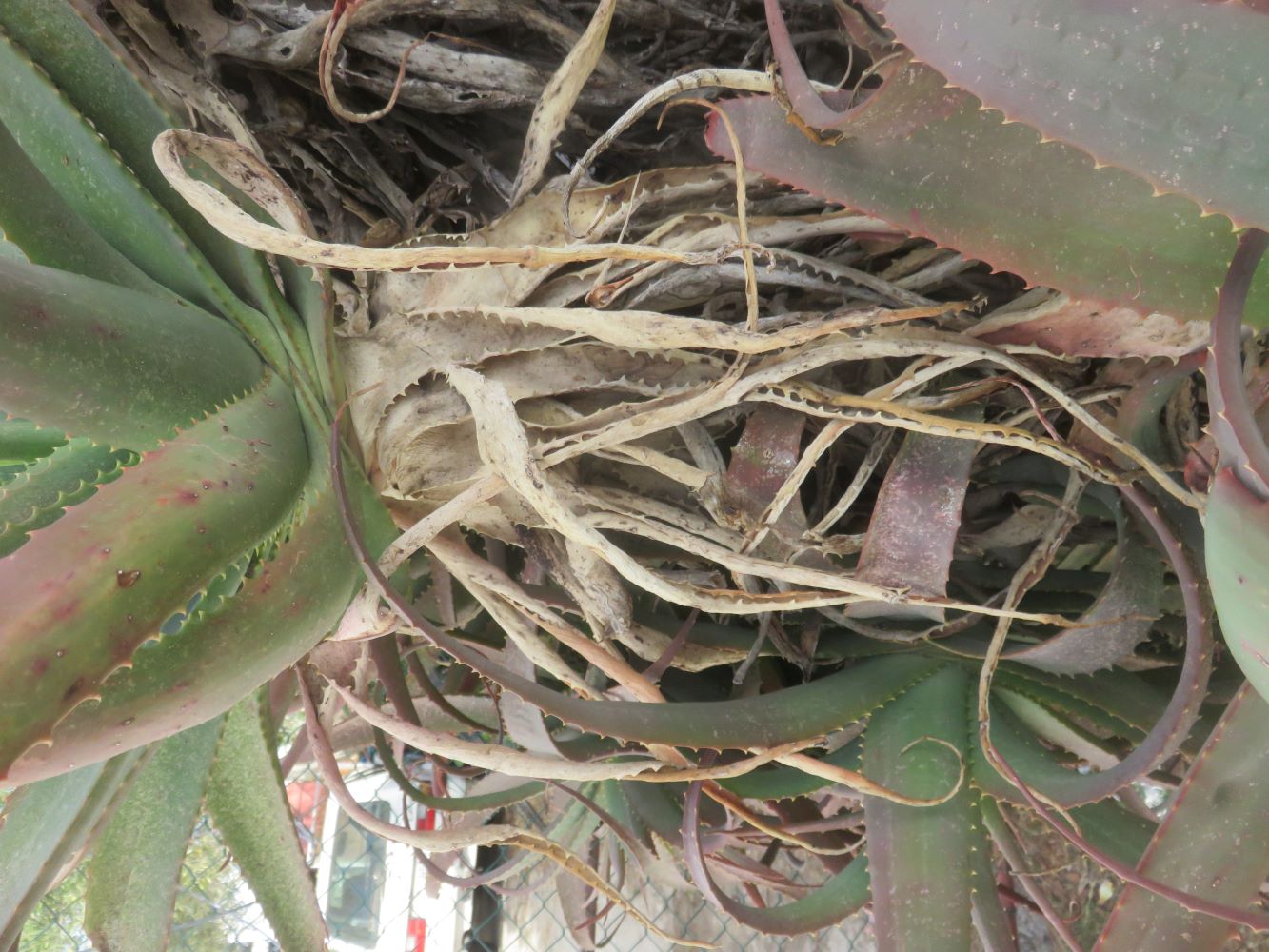 The tangled beard of dried leaves below the heads of the candelabra aloe is nearly impossible to remove and can slash your hands on its teeth.
The tangled beard of dried leaves below the heads of the candelabra aloe is nearly impossible to remove and can slash your hands on its teeth.The position of the candelabra aloe in local planted landscapes
Aloes grow well in the sub tropical regions of South African where farmers settled millennia ago. In rural eastern South Africa aloes, particularly the dense, branching and spiny leaved A. arborescens were planted around cattle pens, the heart of the rural homestead, as natural barriers. The aloe fences can still be seen when the cattle and the people are long gone.
There are homes in my neighborhood in Cape Town where the aloes seem to have been planted like a symbol of homeliness, security, and rural plenitude. They are used in the same way one would use farm implements in the garden like halved wine barrels. Placed in pots either side of the door, the aloes enclose the entrance of the home protectively in comfortable homeliness.
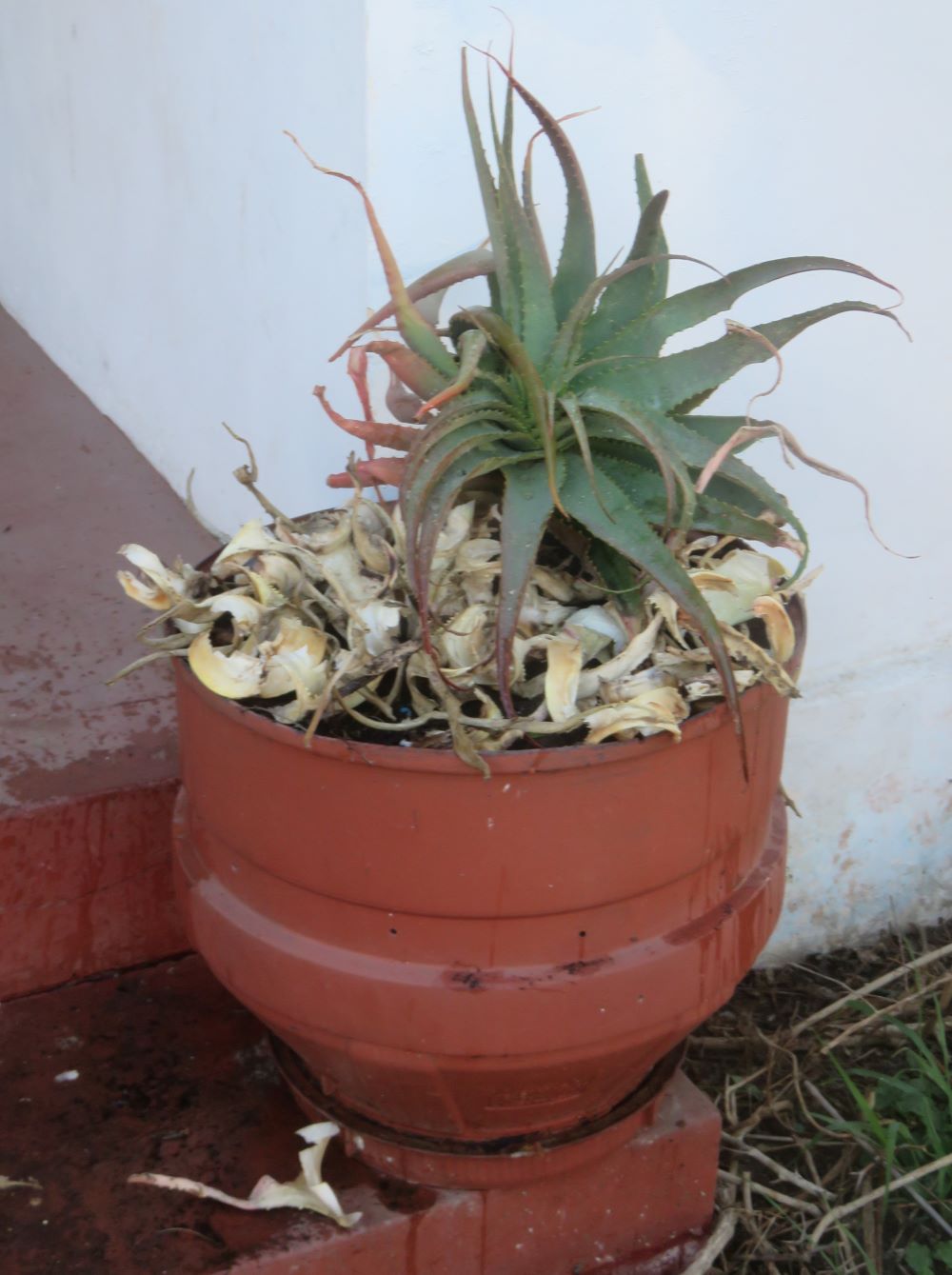 An attempt of mine to use this protective placing of A. arborescens in pots each side of the front door.
An attempt of mine to use this protective placing of A. arborescens in pots each side of the front door.Many areas of the world have much less
plant diversity and yet a far richer iconography or cultural
symbolism for the few plants they do have, such that there are
encyclopedias of plant iconography ! There is so much poetry and
beauty that is lost, ignored or devalued in the story of our plants
and our relationship with them when we ignore, or forget indigenous
plant lore. Unfortunately I was not able to find much local plant lore
on the candelabra aloe on the internet. This knowledge is probably
conveyed person to person.
The splash of winter color it gives and its great flexibility in habitat has led to A. arborescens being one of the most cultivated aloe species in the world. It is also cultivated for medicine in areas outside of Africa.
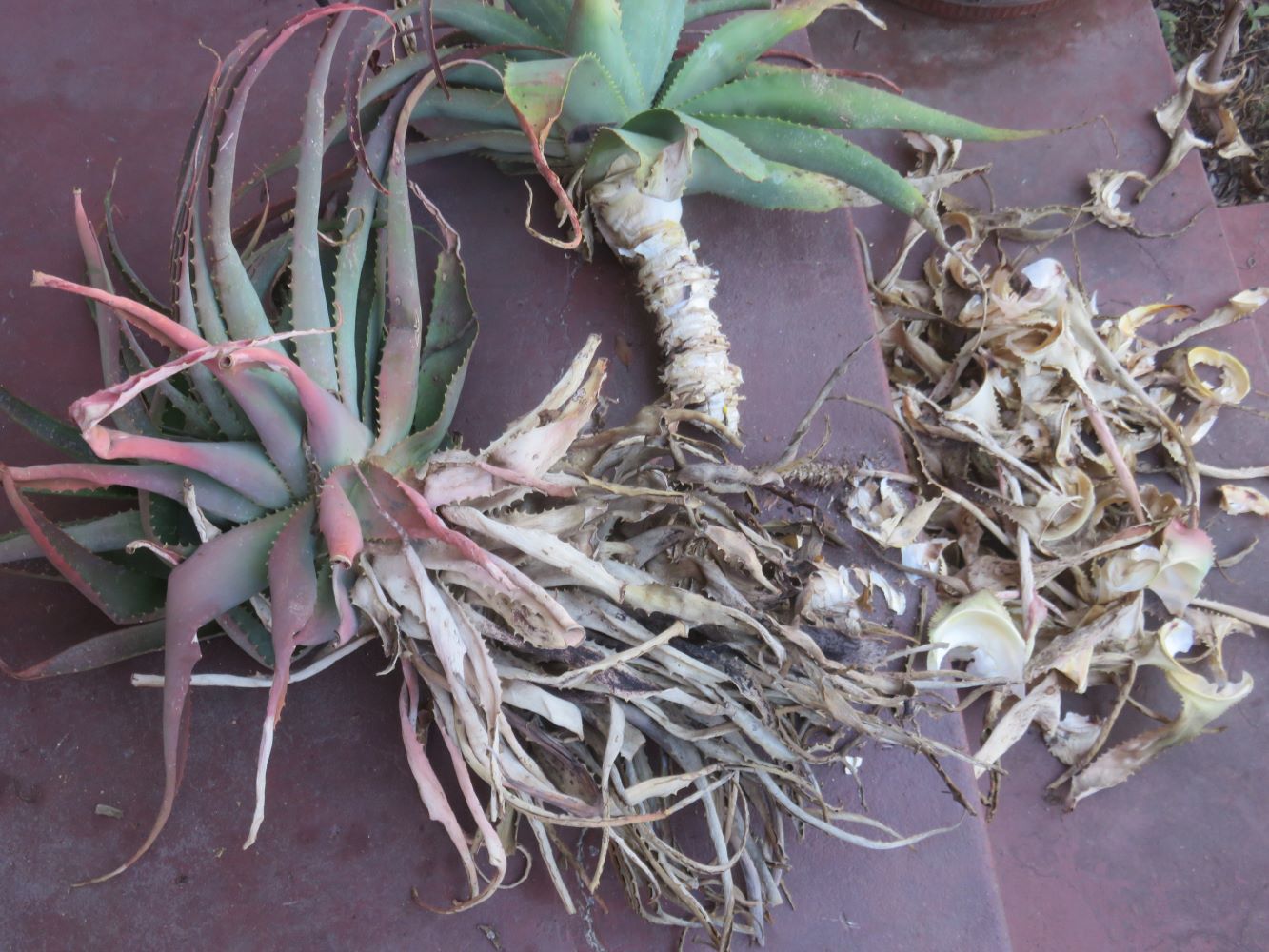 Planting a candelabra aloe truncheon requires removing the hard old beard leaves. Its nearly impossible from the top down but works better from the bottom up, one at a time.
Planting a candelabra aloe truncheon requires removing the hard old beard leaves. Its nearly impossible from the top down but works better from the bottom up, one at a time.European collecting of the candelabra aloe
Aloe arborescens was one of the first South African aloes to be collected and planted in the Company's Garden in Cape Town, and was already grown in Amsterdam in 1674.
Description, habitat and ecology of the candelabra aloe
A. arborescens is a multi-headed, sprawling shrub, typically two to three meters tall. I think it is one of the untidyist looking aloes, and yet this lack of discipline is also its charm. It has leaves with serrated edges, with conspicuous pale teeth. The leaves can become quite red tinged and curled up in the dry months, only to flesh out and become green or greeny grey again when the rains come. The red color is a natural sunscreen found in many desert plants. The serrated sword shaped leaves are arranged in rosettes at the end of the branches. Each rosettte bears two to several inflorescences. These take the form of a raceme and are unbranched. Flowers are cylindrical tube shaped bells, red orange, and born in profusion in mid winter, from May to June. There are also rare forms that bear yellow and bicolored flowers.
Aloe arborescens is known as Kransaalwyn or cliff aloe in Afrikaans as it naturally prefers mountainous areas, rocky outcrops, and exposed ridges, and even cliffs, from sea level to mountain tops. It grows in semi desert as well as in areas with higher rainfall, coastal forests and dense bush. Its natural range is from the South Coast of South Africa, up the eastern regions of Africa all the way through Mozambique and Zimbabwe. to Malawi ! Thus we see it is more commonly found in the summer rainfall regions of the east coast of Africa. However it occurs naturally even on the Cape Peninsula, making it the third widest distributed aloe species.
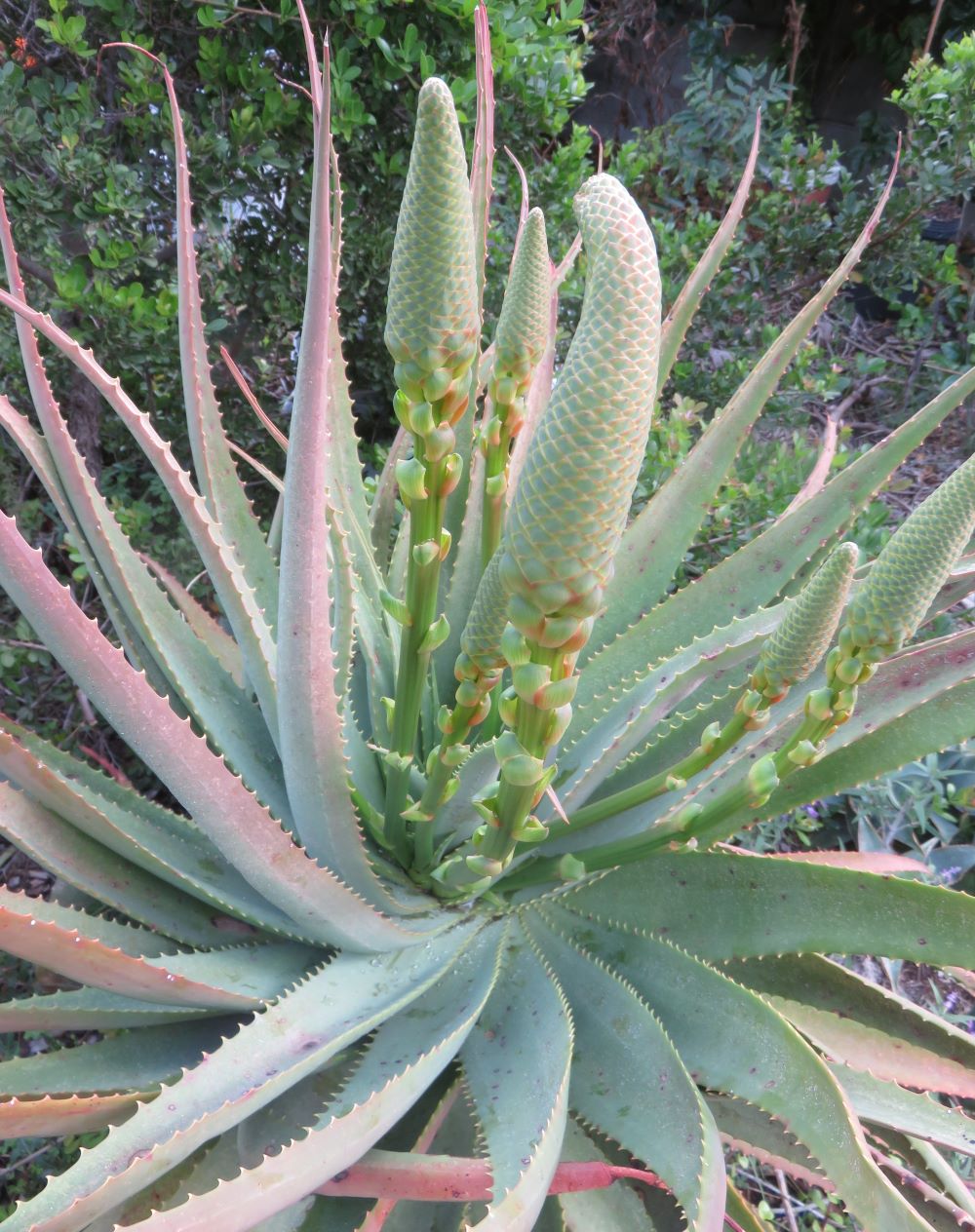 The candelabra aloe flower buds appear in May, the start of our winter, as the leaves green and swell from the winter rain.
The candelabra aloe flower buds appear in May, the start of our winter, as the leaves green and swell from the winter rain.The candelabra aloe's winter
blooming and large vibrantly colored flowers attract birds, bees and
butterflies to its sweet nectar in times when other flowers are in
short supply. It is being planted as part of the sunbird conservation
program. I have seen grey sugarbirds and brilliantly colored green
and red sunbirds even on my aloes in a region of dense suburbia in
Cape Town far from wild nature and the mountain.
Cultivation of the candelabra aloe
A. arborescens is really easy to grow and fast growing. In South Africa its hard to kill it. It likes full sun and well drained soil. Using compost is recommended but in my experience it will grow in quite nutrient deficient sandy soil. It tolerates drought and neglect once established. However it cannot handle heavy frost. It needs a minimum temperature of 10 C or 50 F so it is grown under glass in temperate regions.
Grown as an ornamental or accent plant, it can also form an impenetrable hedge. The large beautiful flowers brighten up the garden in the winter. Its attractive foliage and decorative form make it a good garden subject but it is also a must have for anyone wanting to start a medicinal herb garden using indigenous South African plants.
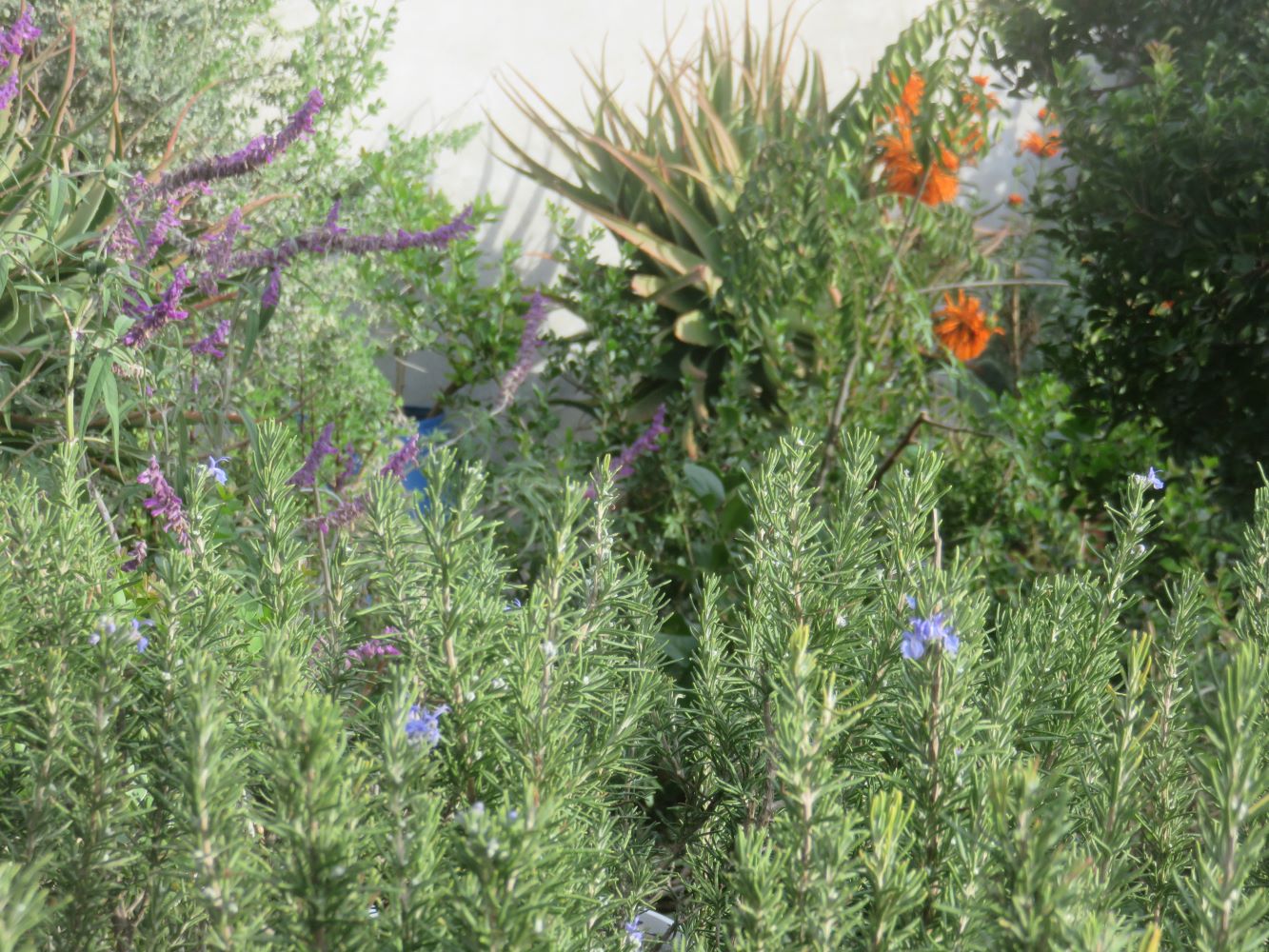 The aloe looks beautiful in my herb garden, against a wall warmed by prevailing sunshine. I've seen it thrive in partial shade too.
The aloe looks beautiful in my herb garden, against a wall warmed by prevailing sunshine. I've seen it thrive in partial shade too.Medicinal use of the candelabra aloe
Within traditional South African herbalism, aloe, dried and powdered, is used as a Zulu protection against storms. Decoctions of the leaves are used in childbirth, for treating sick calves, and in the Transkei for stomach ache. They are also given to chickens to prevent them getting sick. Bar interfering with the weather, the indigenous use of aloe fits into what is now known of its composition and active properties, although it tends to be used differently in other parts of the world, and the uses seem to be unique to each region. I am not sure if it is a classic case of the appropriation of indigenous knowledge because of the diverse applications it has found globally, its wide area of natural distribution, and that aloe has been known as a medicine in Europe for over two thousand years. It is possible that the idea to investigate and experiment with A. arborescens in eastern Europe came from observing traditional knowledge in southern Africa, but the unique local ownership of the knowledge could be hard to prove. A pity because the plant medicine business is so large that compensation for the use of South African plants could alleviate poverty in South Africa.
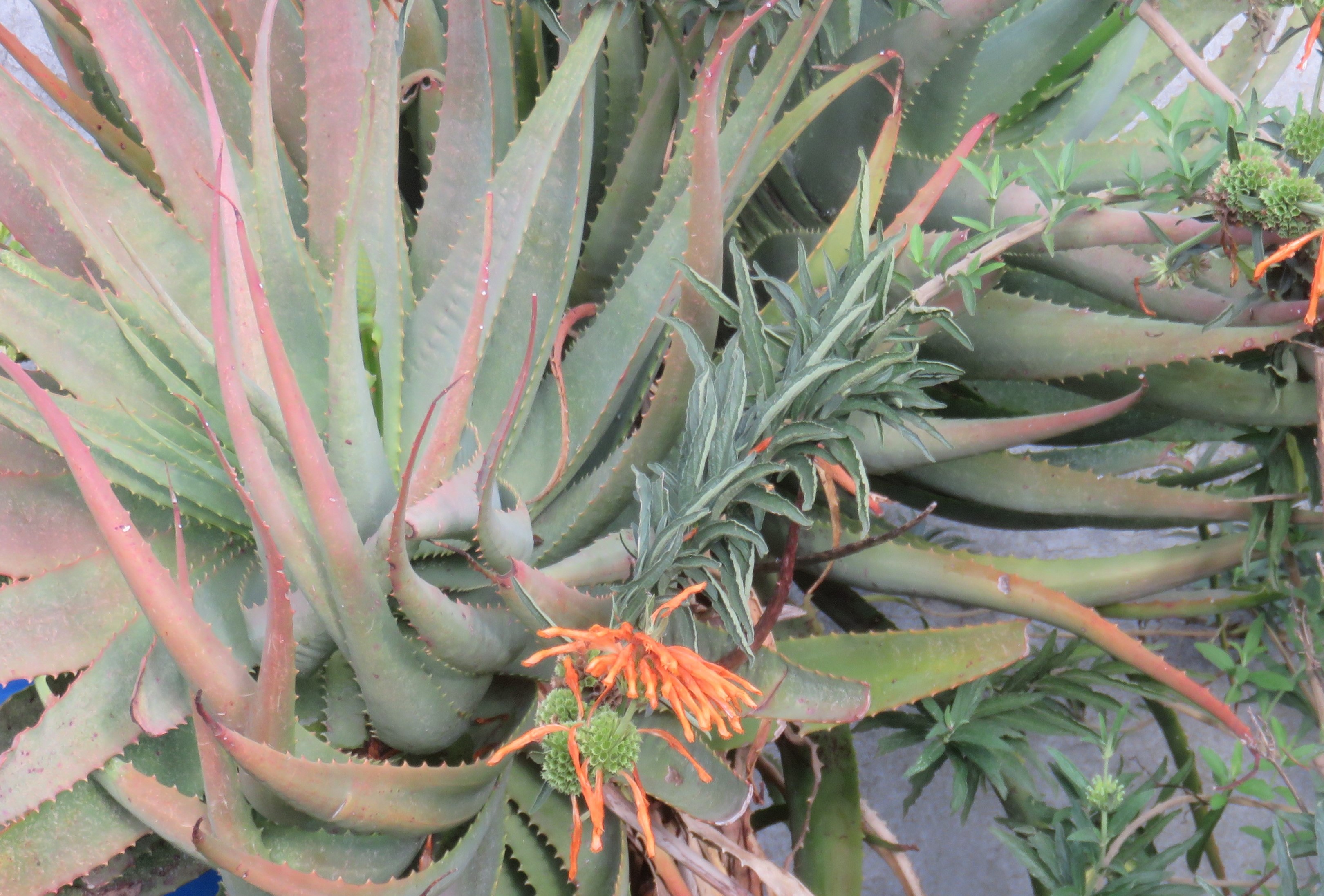 The aloe's own internal medicine, a sunscreen of red coloring which build up in the drought of our hot summers. It fades as winter and the rain comes.
The aloe's own internal medicine, a sunscreen of red coloring which build up in the drought of our hot summers. It fades as winter and the rain comes.Aloe arborescens is used for medicine and food in China, Israel, Italy, Japan, Ukraine and Poland where it is grown in greenhouses.
Aloe arborescens has been used in eastern Europe with enthusiasm since the 1930's where it has a long history of safe use. It is used for respiratory illnesses in children. Aqueous extracts are used for upper respiratory tract infection and prophylaxis. A. arborescens was used in 1935 by W.P. Filarov to suppress graft rejection in cornea transplants. Puchugin recommended its use for respiratory tract infection in 1920. The extract was injected, till syrup was developed. Aqueous extracts are widely used today in eastern Europe. The direct cause of its efficacy is not known, but may be due to the physical nature of the gel.
In the orient it is grown in herb gardens for treating burn wounds and abrasions. It was used to treat irradiation burns after Hiroshima, and since then leaf extracts have been widely investigated and researched.
Aloe vera is very well studied and has a large market backing and fashionable currency. However, Aloe arborescens has many of its beneficial ingredients in greater concentrations, with a significant difference. All aloe species contain anthraquinones. These have beneficial effects, among them laxative properties. Aloe ferox and Aloe barbadensis are well known in European medicine for their laxative effects. This is due to the high hydroxy-anthroquinone content. Most aloes are known as purgatives except A. arborescens as it has a low anthranoid content and doesn't have the same laxative effect.
Many many studies have been done on A. arborescens therapy for children. It has been found to help with uncomplicated non bacterial upper respiratory tract infection, aka the common cold. However the pharmaceutical research paper I saw was backed by an aloe extract producing pharmaceutical company. Their research on its phytochemical properties makes claims for its efficacy in immunomodulation and antiviral activity. It is known as wound-healing, even for Xray burns, anti bacterial, anti ulcer, anti inflammatory, anticarcinogenic and has blood sugar lowering effects. In vitro A.arborescens extracts enhance chemotaxis, phagocytosis and stimulate mitogenic (cell dividing) activity in lymphocytes bound to human alpha two macroglobulin. They have an inhibitory effect on antigen specific immune response, enhance proliferation of macrophages and this reduces reaction to cornea grafts. Aqueous extracts are used for immune stimulation. In test subjects it increased haemoglobin levels and shortened recovery times. It sounds as if it should be investigated for helping with the treatment of COVID19 !
There is a caveat with all aloe consumption. Used in excess aloes can cause congestion and irritation of the pelvic region according to my source. They may contain a carcinongen that reacts with the gut epithelium as thickening has been observed. According to all sources, including the German pharmaceutical article from Vienna, mentioned above, long term use could lead to colorectal cancer as they have genotoxic and tumerogenic potential.
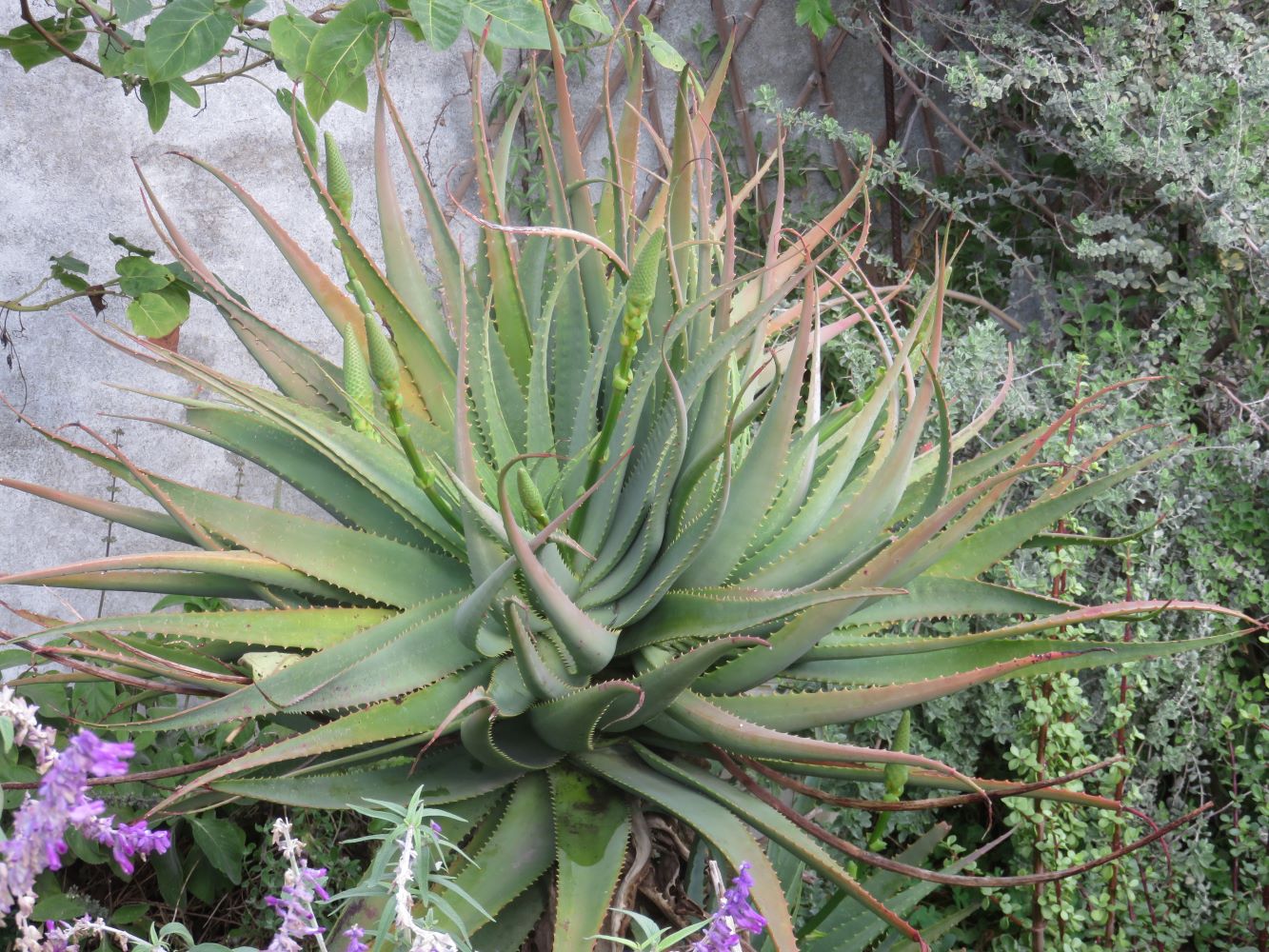 A candelabra aloe growing with some other herbs and edible plants from South Africa and America.
A candelabra aloe growing with some other herbs and edible plants from South Africa and America.The aloe family in South Africa
Aloes are in the family Xanthorrhoeaceae. There are approximately 130 Aloe species native to South Africa.
References for this article
https://pfaf.org/user/Plant.aspx?LatinName=Aloe
wikipedia
http://pza.sanbi.org/aloe-arborescens
P. Bastian, A. Fal, J. Jambor, A. Michalak, B. Noster, H. Sievers, A. Steuber & N. Walas-Marcinek Candelabra aloe (Aloe arborescens). Wiener Medizinische Wochenschrift (Medical weekly of Vienna) vol 163 2013. file:///C:/Users/T440s/Desktop/design/TEXTS/aloe%20arborescens/candelabraaloe.pdf
------
home page for links to many articles on natural gardening, permaculture and growing food
------
our herbal designs and indigenous florals
Restore Nature Newsletter
I've been writing for four years now and I would love to hear from you
Please let me know if you have any questions, comments or stories to share on gardening, permaculture, regenerative agriculture, food forests, natural gardening, do nothing gardening, observations about pests and diseases, foraging, dealing with and using weeds constructively, composting and going offgrid.
SEARCH
Order the Kindle E-book for the SPECIAL PRICE of only
Prices valid till 30.09.2023
Recent Articles
-
Rose
Dec 17, 23 04:08 AM
I am doing research on growing wildlife foraging plants to use in enhancement plantings with wildlife in mind. My thoughts after seeing bears too skinny -
Seeds for a bred Sweeter less acidic Kei apple
Nov 20, 23 03:24 AM
Greetings Greenidiom, I'm a small farmer in kenya. I'm looking to plant a Green fence around a 6 acre plot of land and, I'd wish to make it of kei apples -
Mrs Laura Robinson
Oct 08, 23 02:17 AM
How do I get a copy of the soil aggregation poster??
"How to start a profitable worm business on a shoestring budget
Order a printed copy from "Amazon" at the SPECIAL PRICE of only
or a digital version from the "Kindle" store at the SPECIAL PRICE of only
Prices valid till 30.09.2023






